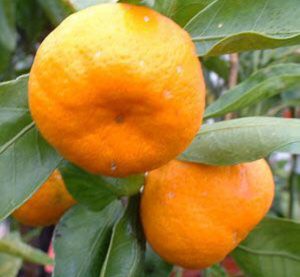by Laurie Osgood | Feb 14, 2017
February has been designated National Snack Month by the Snack Food Association of America, and the National Potato Promotion Board.
As Americans, the one thing that we can all agree on is our love of snacks. Snack sales in the United States top $60 Billion annually. The snack foods that we tend to reach for can be loaded with calories, sugar, sodium and fat. However, snack foods do not have to be unhealthy to satisfy your cravings. When you need a little boost of energy during the day, a healthy snack can do the trick.
According to University of Florida’s Karla Shelnutt, Associate Professor and Extension Nutrition Specialist, and Julie Martinez, healthy snacking is an important part of a child’s daily intake. The key is to learn how to make healthy snack choices and to avoid consuming too many snacks high in sugar and salt, and low in healthy nutrients (http://edis.ifas.ufl.edu/topic_snacks ).
The key to healthy snacking is to plan ahead. Keep a variety of tasty, healthy snacks on hand to help to tide your family over in between meals. When shopping for your family, remember to select healthier items such as fresh fruits and vegetables and make sure to read food labels when selecting pre-packaged snacks.
Additional healthy snacking ideas:
- Cut back on the high-calorie snacks. Choose fruits, vegetables and whole grains, like popcorn.

- Snack when you are hungry, not when your are bored or stressed. Know the difference!
- Eat sensible portion sizes; use single serve containers for snacks.
- Quench your thirst with water, instead of high sugar drinks.
Healthy snack suggestions:
- Ants on a log — Peanut butter filled celery sticks, topped with raisins.
- Healthy ice pops — Pour 100% juice into ice cube trays and freeze.
- Slices of apple with peanut butter
- Smoothies with fat-free milk and frozen strawberries
- Yogurt and fresh fruit
- Crackers and cheese sticks
For more information on the importance of healthy snacking, contact your Family and Consumer Science Agent at your local UF/IFAS Extension Office.
Sources:
Raising Healthy Children: The Role of Snacking. Julie M. Martinez and Karla P. Shelnutt. UF/IFAS EDIS, FCS8902/FY1154. http://edis.ifas.ufl.edu/topic_snacks
Academy of Nutrition and Dietetics. http://www.eatrightpro.org/resource/media/press-releases/national-nutrition-month/during-nnm-make-sensible-snacks-part-of-your-healthy-eating-planpro-press-release
by Laurie Osgood | Jan 27, 2017
It’s that time of year again – time to make resolutions designed to improve your life to become a happier, healthier, and wealthier person. Unfortunately, some resolutions are not realistic and set us up for failure from the start. A very small percentage of us manage to maintain these lofty resolutions.
However, there are small changes you can make today that can help you enjoy a healthy lifestyle. You can start by simply reading the nutrition fact labels on your favorite foods. Smart dietary choices include eliminating or cutting back on these 5 commonly used food items.

- Added Sugar: Some foods, such as milk (lactose) and fruits (fructose), naturally contain sugars. Added sugars (like sucrose and high fructose corn syrup) are added to prepared foods and drinks. Many prepared and processed foods are stocked with added or refined sugars for supplemental sweetness. Added sugars are often called “empty” calories, because they contain extra calories and few or no vitamins and minerals, and can lead to extra pounds or even obesity, thereby reducing heart health. Alternatives: Instead of eating foods with a lot of added sugar, try a piece of fruit or use other options such as raw honey, Stevia or maple syrup.
- Sodium: is found in many processed foods, and is commonly known as salt. Excess sodium increases blood pressure because it holds excess fluid in the body, and that creates an added burden on the heart. Too much sodium will increase your risk of stroke, heart failure, osteoporosis, and some cancers. Alternatives: You can reduce the amount of sodium in your diet by limiting the amount of salt you add to your foods, avoiding processed foods, and by choosing “reduced sodium,” “no sodium added,” or “low sodium” options when available. Try experimenting with fresh or dried herbs/seasonings to flavor to foods without adding salt.
- Enriched Flour: this ingredient is included in many of the processed foods that we eat including pasta, cereals and breads. Whole grain flours are often stripped of their nutrients. Then, to be considered enriched, vitamins, sugar, and other additives are added back in. Alternatives: Instead of white bread, pasta or rice, choose whole grain products instead.
- Saturated Animal Fats: this type of fact, in the form of lard, butter, eggs, cheese, and tallow come primarily from animals and are known to cause health issues such as high cholesterol and heart disease. Minimizing intake of unhealthy fats allows you to reduce calorie intake in a healthy manner. Unsaturated fats offer important health benefits and should be included in everyone’s diet. Alternatives: A simple alternative to saturated fats in your diet can be unsaturated fats found in non-animal, plant products such as fruits & vegetables, oils, nuts and seeds.
- Hydrogenated Oils; commonly called Trans fats, or Trans Fatty Acids. Hydrogenation is the process of converting a pourable oil into a more solid, saturated fat, and is often added to a product in order to extend its shelf life. Partially or fully hydrogenated oils promote cardiovascular diseases by raising your bad (LDL) cholesterol levels and lowering your good (HDL) cholesterol levels. Alternatives: Choose oils that are high in polyunsaturated and monounsaturated fat, such as olive, safflower and peanut oils. Another healthy alternative to hydrogenated oil is Omega- 3 oils from fish. Also, try broiling foods instead of frying.
Overly ambitious New Year’s Resolutions often fail because they require major changes in a very short amount of time, making them almost impossible to stick with. Instead of broad, life changing goals, your New Year’s Resolution should include small lifestyle changes, such as starting with cutting back on or eliminating these 5 items.
Resources:
University of Florida IFAS Extension;
http://edis.ifas.ufl.edu/fy1400
American Heart Association:
http://www.heart.org/HEARTORG/HealthyLiving/HealthyEating/Nutrition/Added-Sugars_UCM_305858_Article.jsp#.WG1D0k0zWLw
USDA Choose MyPlate.gov:
https://www.choosemyplate.gov/myplate-mywins
Footnotes:
Laurie B. Osgood, Family and Consumer Sciences Agent, Gadsden County Extension, UF/IFAS Extension, Quincy, FL 32351 (850) 662-3287 Osgoodlb@ufl.edu
The Institute of Food and Agricultural Sciences (IFAS) is an Equal Opportunity Institution authorized to provide research, educational information and other services only to individuals and institutions that function with non-discrimination with respect to race, creed, color, religion, age, disability, sex, sexual orientation, marital status, national origin, political opinions or affiliations. For more information on obtaining other UF/IFAS Extension publications, contact your county’s UF/IFAS Extension office.
U.S. Department of Agriculture, UF/IFAS Extension Service, University of Florida, IFAS, Florida A & M University Cooperative Extension Program, and Boards of County Commissioners Cooperating. Nick T. Place, dean for UF/IFAS Extension.
by Melanie Taylor | Jan 6, 2017
 January’s grain of the month is OATS. Americans buy more oats at this time of year than in any other month – and January has long been celebrated as National Oatmeal Month.
January’s grain of the month is OATS. Americans buy more oats at this time of year than in any other month – and January has long been celebrated as National Oatmeal Month.
Oats at a Glance
Samuel Johnson’s 1755 dictionary defined oats as “A grain, which in England is generally given to horses, but in Scotland appears to support the people.” The Scotsman’s retort to this was, “That’s why England has such good horses, and Scotland has such fine men!” Oats (Avena sativa) have a sweet flavor that makes them a favorite for breakfast cereals. Unique among the most widely-eaten grains, oats almost never have their bran and germ removed in processing. So, if you see oats or oat flour on the label, relax; you’re virtually guaranteed to be getting whole grain.
In the U.S., most oats are steamed and flattened to produce rolled oats, sold as “old-fashioned” or regular oats, quick oats, and instant oats. The more oats are flattened and steamed, the quicker they cook – and the softer they become. If you prefer a chewier, nuttier texture, consider steel-cut oats, also sometimes called Irish or Scottish oats. Steel-cut oats consist of the entire oat kernel (similar in look to a grain of rice), sliced once or twice into smaller pieces to help water penetrate and cook the grain. Cooked for about 20-30 minutes, steel-cut oats create a breakfast porridge that delights many people who didn’t realize they love oatmeal!
Health Benefits of Oats
Scores of studies have documented the many health benefits of oats:
- Eating oats helps lower LDL “bad” cholesterol and may help reduce the risk of heart disease.
- Oats help you feel fuller longer, which helps control your weight.
- Oatmeal and oats may help lower blood pressure.
- Oats may help reduce your risk of type 2 diabetes, since their soluble fiber helps control blood sugar.
- Oats help cut the use of laxatives without the side effects associated with medications.
- Oats are high in beta-glucans, a kind of starch that stimulates the immune system and inhibits tumors. This may help reduce your risk of some cancers.
- Early introduction of oats in children’s diets may help reduce their risk of asthma.
- Oats are higher in protein and healthy fats and lower in carbohydrates than most other whole grains.
- Oats contain more than 20 unique polyphenols called avenanthramides, which have strong anti-oxidant, anti-inflammatory, and anti-itching activity.
Meal Ideas
Think oats are limited to breakfast cereals, cookies, and snack bars? Think again! Oats can be used in place of bread crumbs in meatloaf and hamburgers, in side dishes, and as a crispy coating. Check out these recipes for healthy, new ways to use oats:
For additional oat recipes you may want to try at home, visit: http://wholegrainscouncil.org/
Source: Whole Grains Council at http://wholegrainscouncil.org/
by Laurie Osgood | Dec 3, 2016
 It’s the fall season, and Satsumas are hitting the shelves at your local grocery store. Satsumas are a seedless variety of the mandarin orange, and are harvested during the fall and early winter. Satsumas are grown in the cool, sub-tropical areas of California, Florida, Alabama, Louisiana, Mississippi and Texas. Because of their thin skin, satsumas are sweet and easy to peel. Whether you are buying satsumas from your local grocery store, farmers market or roadside stand, it is very important to purchase all of your citrus from a reputable vendor.
It’s the fall season, and Satsumas are hitting the shelves at your local grocery store. Satsumas are a seedless variety of the mandarin orange, and are harvested during the fall and early winter. Satsumas are grown in the cool, sub-tropical areas of California, Florida, Alabama, Louisiana, Mississippi and Texas. Because of their thin skin, satsumas are sweet and easy to peel. Whether you are buying satsumas from your local grocery store, farmers market or roadside stand, it is very important to purchase all of your citrus from a reputable vendor.
Satsuma Trees:
Satsuma trees are small to medium in size, and can easily tolerate the cooler fall temperatures that the Florida Panhandle is known for. Satsuma trees are relatively easy to grow and make an attractive addition to your home landscape. Picking fresh fruit off of your own tree provides a much fresher, and cost efficient treat. Satsuma trees are best started in a container and then transferred into the ground. When choosing a spot to plant a satsuma tree, remember that citrus trees need full sun.
 “Before planting any new plants, you should always conduct a soil sample, to determine if there are any issues in the soil where you will plan the satsuma tree” said DJ Wiggin, Small Farms Agent with the Florida A&M University Extension Program in Gadsden County. If you would like to request a soil sample test kit, you should contact your local UF/IFAS Extension office.
“Before planting any new plants, you should always conduct a soil sample, to determine if there are any issues in the soil where you will plan the satsuma tree” said DJ Wiggin, Small Farms Agent with the Florida A&M University Extension Program in Gadsden County. If you would like to request a soil sample test kit, you should contact your local UF/IFAS Extension office.
Fruit Bearing Season:
Satsuma oranges have a relatively brief fruit bearing season, between October and December. This short season give the satsuma oranges their rich flavor. A few nights with temperatures that drop into the 40s, help improve their sweetness. However, the fruit of the satsuma tree should be picked promptly when ripe, because the heavy fruit could cause damage to some weaker limbs of the tree.
According to DJ Wiggins, “When properly stored, satsumas have a shelf life of several weeks”. Satsuma oranges can be juiced, eaten as a snack, or used in recipes, including Orange marmalade.
Recipe Source: Adapted from So Easy to Preserve, from the Cooperative Extension at The University of Georgia.
Orange Marmalade
Yields about 7 half-pint jars
• 4 cups thinly slices Orange Peel (about 6 large oranges or 32 Satsumas)
• 4 cups Orange Pulp, cut up (about 6 large oranges or 32 Satsumas)
• 1 thinly sliced Lemon (about 2 medium)
• 6 cups of Water
• Sugar (about 6 cups)
Directions:
To Prepare the Fruit- Add water and fruit together in a saucepan. Heat to simmer for 5 minutes. Cover and let stand 12 to 18 hours in refrigerator. Heat and cook over medium heat until peel is tender, about 1 hour. (Note: When peeling citrus fruits for marmalades, be sure to include some of the white membrane found just under the skin. This is where most of the pectin is located.)
To Make Marmalade– Sterilize canning jars. Measure fruit and liquid. Add 1 cup sugar for each cup of fruit mixture. Bring slowly to boil, stirring until sugar dissolves. Cook rapidly to the jellying point (25 minutes), stirring occasionally. Pour hot marmalade into hot, sterile ½ pint jars, leaving ¼ inch headspace. Wipe jar rims with a dampened clean paper towel and adjust lids. Process 5 minutes in a Boiling Water Canner.
Interested in Learning More about Canning Fruits and Vegetables? The Gadsden County Extension Program offers Water Bath Canning Classes throughout the year, to learn more, call us at (850) 875-7255.
Resources:
University of Florida IFAS Extension. The Satsuma Mandarin, Peter C. Andersen and James J. Ferguson, Revised November 2015
http://edis.ifas.ufl.edu/pdffiles/CH/CH11600.pdf
University of Alabama Extension, Satsuma Season: Enjoying the Christmas Orange, James Miles and Emma Sager, November 10, 2014
http://news.aces.edu/blog/2014/11/10/satsumaseason/
University of Georgia Extension: Citrus Fruit for Southern and Coastal Georgia, Krewer and Powell, Extension Fruit Specialists.
http://extension.uga.edu/publications/detail.cfm?number=B804
Recipe: Reynolds, Susan, Paulette Williams, Judy A. Harrison, and Susan J. Reynolds. So Easy to Preserve. Athens: Cooperative Extension Service, U of Georgia, College of Family and Consumer Sciences, College of Agricultural and Environmental Sciences, 2006. Page 218
The Institute of Food and Agricultural Sciences (IFAS) is an Equal Opportunity Institution authorized to provide research, educational information and other services only to individuals and institutions that function with non-discrimination with respect to race, creed, color, religion, age, disability, sex, sexual orientation, marital status, national origin, political opinions or affiliations. For more information on obtaining other UF/IFAS Extension publications, contact your county’s UF/IFAS Extension office.
U.S. Department of Agriculture, UF/IFAS Extension Service, University of Florida, IFAS, Florida A & M University Cooperative Extension Program, and Boards of County Commissioners Cooperating. Nick T. Place, dean for UF/IFAS Extension.
Coauthors:
Laurie Osgood, Family and Consumer Science Agent, UF/IFAS Extension, Gadsden County
DJ Wiggins, Small Farms Agent, Florida A&M University Extension, Gadsden County
by Heidi Copeland | Nov 30, 2016
 Many of us can agree, being around family can make simple things in life more special! Whether it’s time spent together during holidays, celebrating birthdays, or simply enjoying togetherness, family events can make life memorable. Why wait until special occasions to show your family that they matter? Dining together can make simple things feel special every day!
Many of us can agree, being around family can make simple things in life more special! Whether it’s time spent together during holidays, celebrating birthdays, or simply enjoying togetherness, family events can make life memorable. Why wait until special occasions to show your family that they matter? Dining together can make simple things feel special every day!
Dining in with your family is one of the easiest ways to incorporate spending quality time together… on a daily basis. Knowing that schedules can make this task very difficult to implement but understanding the benefits will help encourage us to make the time for this important ritual. Research studies show that frequent, positive mealtime experiences can lead to better communication among family members, improved performance at school, and enhanced reading levels, as well as better overall nutrition. During meals, parents are able to teach their children how to actively listen and express themselves through conversation. As a result, these mealtime conversations expand children’s vocabulary and increase their reading skills. Equally important is that eating together helps encourage healthy eating habits.
Make plans to set aside December 3, 2016 as Dine in Day. This initiative, started three years ago by the American Association of Family and Consumer Sciences (AAFCS) promotes the importance of group meals in fostering family and community relationships, encouraging healthy diets and stretching food dollars. AAFCS cares about family mealtimes and is spreading awareness.
Here are some Dine In Day conversation starters and tips to create an enjoyable and relaxing atmosphere for your family:
- Start with minimal distractions. Turn off all devises…televisions, iPads, laptops, and set aside cell phones.
- For families with preschoolers here are some conversation starters
- If you could be any animal in the world for a day, which animal would it be? Why?
- What made you happy (or sad) today? Why?
- Who did you sit next to (or play with) at school today? What did you talk about?
- Would you like to help plan dinner for tomorrow night? What foods would you like to help cook for dinner?
- For families with adolescents and young adults here are some conversation starters
- Ask about their hobbies, clubs, or extracurricular activities
- If you could have one day free of all responsibilities what would you do?
- Share funny stories and discuss light current events
Remember, eating together matters. Try to create a positive atmosphere before and during meals.
- Respect and involve every family member giving everyone an equal opportunity to share an opinion without teasing or criticizing.
- Download free conversation starters at www.school-wellness.org
- Background music can be a nice addition!
Individuals, families and groups can pledge to dine in December 3 at http://bit.ly/2dPj58G . Diners can also participate on social media by sharing photos and using the hashtags #FCSdayFL and #healthyfamselfie.
Build stronger relationships and positively impact your children’s growing values. Don’t wait until special occasions to reap the dining together benefits, dine in now!
For more information on the importance of family meal
- Lyttle and E. Baugh, The Importance of Family Dinners (FCS2286), Department of Family, Youth and Community Sciences (Archived).
- Paredes and K. Shelnutt, Raising Healthy Children: The Importance of Family Meals (FCS8925), Department of Family, Youth and Community Sciences (06/2010).
Tamarah Ulysse FSU Intern, Family and Child Sciences
Edited by: Heidi Copeland
Extension Agent I
Family and Consumer Sciences
615 Paul Russell Road
Tallahassee, FL 32301-7060
850/606-5200
by Pam Allen | Nov 25, 2016
 It is that time of year when we think about giving special gifts to the people in our lives that mean the most to us. Your list might include teachers, neighbors, friends and co-workers. Gifts don’t have to be expensive, it is the thought behind the gesture that means the most to your friends and family. Whoever is on your list this year, think about using your kitchen as grand central for gift making. Gifts of food are heart felt and send a message that you spent time making something special that looks good and tastes yummy. These gifts say thank you in a thoughtful way. Don’t forget to include your kids in the process of cooking and assembling gifts to teach them something about budgeting and enjoying the simple pleasure of gift giving.
It is that time of year when we think about giving special gifts to the people in our lives that mean the most to us. Your list might include teachers, neighbors, friends and co-workers. Gifts don’t have to be expensive, it is the thought behind the gesture that means the most to your friends and family. Whoever is on your list this year, think about using your kitchen as grand central for gift making. Gifts of food are heart felt and send a message that you spent time making something special that looks good and tastes yummy. These gifts say thank you in a thoughtful way. Don’t forget to include your kids in the process of cooking and assembling gifts to teach them something about budgeting and enjoying the simple pleasure of gift giving.
The way the gift is presented can be just as important as the food itself. Try to pair up containers with the food gift that will be used after the food is gone. This can be a gift that keeps on giving. Examples are a decorative plate filled with cookies, pie plate filled with your favorite pie or a trifle bowl filled with goodies. You get the idea. Another thought is to put together items that say “sit and take a break” like a loaf of quick bread paired with a pound of coffee, homemade salsa with chips and a favorite beverage. The main goal is to show that you put thought in the gift and spent time preparing the presentation.
With everyone watching their budgets this year, plan ahead to get the creative juices working by purchasing ingredients on sale and found locally. Local products in December include pecans, sweet potatoes, honey, peanuts, persimmons, satsumas and jams and jellies sold at local farmers markets. So get going and unleash your creativity, and give a few gifts from your kitchen and your heart. Have fun making these gifts, and remember to enjoy the process.
One of my favorite festive cookie is the Chocolate Crinkle. The crackle on top with the chocolate and white sugar says it is holiday time. These cookies make a good food gift as they stay firm and will last up to a week. They also freeze well if you need to make ahead of time. Package the gift by placing on a nice festive plate and wrap with clear wrap and decorate with ribbon.
Chocolate Crinkle Cookie
½ cup of shortening
1 2/3 cup sugar
2 tsp vanilla
2 eggs
Two 1 ounce squares of unsweetened chocolate (melted)
2 cups sifted all-purpose flour
2 tsp baking powder
½ tsp salt
1/3 cup of milk
½ cup chopped walnuts or pecans (optional)
Cream together the shortening, sugar and vanilla. Beat in the two eggs then add the melted chocolate. In another bowl, sift together the flour, baking powder and salt. Add flour mixture slowly to creamed mixture alternating with the milk until thoroughly blended. Stir in walnuts. Chill for 3 hours. Form in 1 – inch balls and roll in confectioners’ sugar. Place on greased cookie sheet 2 to 3 inches apart. Bake in moderate oven at 350 degrees for 15 minutes. Cool slightly then remove from pan. Makes 48.
They are now ready to put in a container and give to friends. This cookie freezes well.
Prepare this nut bread then decorate with wrapping and ribbon. You might include the loaf pan as part of the gift. Include a brick of cream cheese along with a decorative butter knife for a complete package.
Cranberry Nut Bread
Ingredients
2 cups all-purpose flour
1 cup sugar
1 1/2 teaspoons baking powder
¾ teaspoon salt
1/2 teaspoon baking soda
3/4 cup orange juice
1 tablespoon grated orange peel
2 tablespoons shortening
1 egg, well beaten
1 tsp vanilla flavoring
1 1/2 cups Fresh Cranberries, coarsely chopped
1/2 cup chopped nuts (walnuts or pecans)
Directions
Preheat oven to 350 degrees. Grease a 9 x 5-inch loaf pan. Mix together flour, sugar, baking powder, salt and baking soda in a medium mixing bowl. Stir in orange juice, orange peel, shortening and egg and vanilla. Mix until well blended. Stir in cranberries and nuts. Spread evenly in loaf pan. Bake for 55 minutes or until a toothpick inserted in the center comes out clean. Cool on a rack for 15 minutes. Remove from pan; cool completely. Makes 1 loaf (16 slices). Bake loaf in decorative pan as part of the gift. Make sure you cool after cooking then replace in pan and wrap as part of the gift.
The Real Sweet Potato Pie
Use local sweet potatoes to promote locally grown produce. After baking, cool then give as a gift in a nice pie plate. Wrap, refrigerate with instructions on reheating for serving. For added effect, bundle with whipped cream and pie knife.
Pre Preparation
Prepare your sweet potatoes for the pie mix. Select 6 – 7 large sweet potatoes and cut in half or quarters. Boil potatoes slowly for about 30 minutes. Let cool. Peel potatoes after they cool. The peel should come off very easy. Measure six cups of sweet potato in a mixing bowl. Use a stand mixer to beat the sweet potatoes and do not scrape off any mixture from beaters. This will contain the stringy part and you do not want it in your pie. Discard the strings.
Ingredients
6 cups cooked mashed sweet potatoes
1 cup evaporated milk
½ cup butter
2 tsp vanilla flavoring
2 tsp nutmeg
1 tsp butter flavoring
4 eggs
1 cup sugar
Mix all ingredients in a stand mixer until well blended. The mixture should be smooth and free of lumps. The mixture will keep in the refrigerator up to a week and may be frozen for future use. Be sure to label with date and amount before placing in freezer.
For the Pie
Place mixture in unbaked pie shell and smooth to the edges. You will need about 2 ½ cups for each 9 inch deep dish pie shell. Mini tart shells may also be used for individual pies. This recipe makes about 3 pies or 12 individual mini pie tarts. Cook at 350 degrees until puffed and browned slightly on top. About 40 minutes.
Visit your local farmers market to purchase local nuts, honey, produce and jams and jellies. Be sure to look for locally grown and support our area growers. For additional information about local produce visit: http://wfrec.ifas.ufl.edu/panhandle-produce-pointers/







